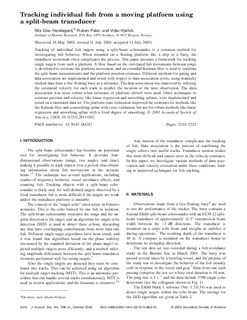Tracking individual fish from a moving platform using a split-beam transducer
Journal article, Peer reviewed
Permanent lenke
http://hdl.handle.net/11250/108934Utgivelsesdato
2005Metadata
Vis full innførselSamlinger
- Articles [3012]
Originalversjon
http://dx.doi.org/10.1121/1.2011410Sammendrag
Tracking of individual fish targets using a split-beam echosounder is a common method for investigating fish behavior. When mounted on a floating platform like a ship or a buoy, the transducer movement often complicates the process. This paper presents a framework for tracking single targets from such a platform. A filter based on the correlated fish movements between pings is developed to estimate the platform movement, and an extended Kalman filter is used to combine the split-beam measurements and the platform-position estimates. Different methods for gating and data association are implemented and tested with respect to data-association errors, using manually tracked data from a free-floating buoy as a reference. The data association was improved by utilizing the estimated velocity for each track to predict the location of the next observation. The data association was more robust when estimates of platform tilt/roll were used. Other techniques to estimate position and velocity, like linear regression and smoothing splines, were implemented and tested on a simulated data set. The platform-state estimation improved the estimates for methods like the Kalman filter and a smoothing spline with cross validation, but not for robust methods like linear regression and smoothing spline with a fixed degree of smoothing.
